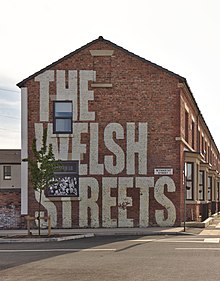
Toxteth is an inner-city area of Liverpool in the county of Merseyside.

Dingle is an inner city area of Liverpool, Merseyside, England. It is located to the south of the city, bordered by the adjoining districts of Toxteth and Aigburth. At the 2001 Census, the population was recorded at 13,246.

Back-to-backs are a form of terraced houses in the United Kingdom, built from the late 18th century through to the early 20th century in various forms. Many thousands of these dwellings were built during the Industrial Revolution for the rapidly increasing population of expanding factory towns. Back-to-backs share party walls on two or three of their four sides, with the front wall having the only door and windows.

10 Admiral Grove, a property in Toxteth, Liverpool, England, is the house in which Ringo Starr lived for twenty years before he rose to fame with the Beatles.
The Housing Market Renewal Initiative (HMRI) or Housing Market Renewal (HMR) Pathfinders programme was a controversial scheme of demolition, refurbishment and new-building which ran in the UK between 2002 and 2011 and aimed "to renew failing housing markets in nine designated areas of the North and Midlands of England."
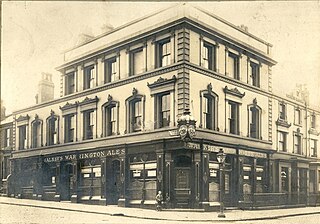
The Royal Park Hotel was a three storey, handsome public house and hotel situated on the corner of Admiral Street and North Hill Street, Toxteth, Liverpool, England. It was built in the 1860s1 as a three-storey building possibly by the brewer Walkers of Warrington. A long bar ran the length of the pub curving at the end; two other rooms had no bar and were served by waiter service, which disappeared towards the end of the pub's life. The name of the pub probably refers to the fact that Toxteth was a Royal Park - although in the interwar years the name changed to the Admiral Hotel.2 In the 1871 England Census, it is recorded as being at 2 Admiral Street, Toxteth Park and in Ordnance Survey maps of the period it is marked as a PH on the corner of Admiral Street and North Hill Street - with a Freemasons' hall adjacent to it at 80 North Hill Street. However, in some Censuses the hotel is recorded as being at 84 North Hill Street.

Caia Park is a suburb and community in Wrexham, Wrexham County Borough, Wales. It was created in 1985 after a Boundary Commission review of the four community areas within Wrexham, of which Caia Park occupies its east, with the others being Acton, Offa, and Rhosddu. At the 2001 census, the community had a population of 11,882 in 5,019 households, increasing to 12,602 in 2011.

Derker is an area of Oldham, in Greater Manchester, England. It lies in north-central Oldham, close to the boundary with Royton.
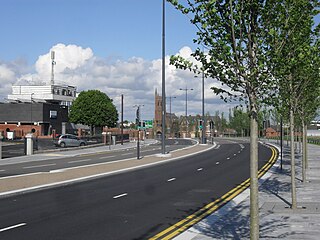
Edge Lane is a main road running from the periphery of Liverpool city centre at Hall Lane towards the M62 motorway. Edge Lane technically comprises two roads, that of 'Edge Lane' and that of 'Edge Lane Drive' and passes through the districts of Old Swan, Kensington, Wavertree and Edge Hill. It forms part of the A5047.
The Woolstore Precinct is a residential area in the suburb of Teneriffe in Brisbane, Queensland, Australia. A former industrial and commercial area, it has undergone urban renewal with preservation and re-purposing of many buildings from the early 20th century. This renewal has been guided by neighbourhood plans formulated by Brisbane City Council, with advice from the Queensland Heritage Council.

The Excalibur Estate was a post-war 1940s housing estate of 189 prefabricated houses in Catford, South London. The estate contained the last sizeable collection of post-war prefabricated houses in the United Kingdom. In 2011, Lewisham Council approved a plan to replace the prefabs with 371 houses, with demolition scheduled to begin in 2013. English Heritage has granted listed building status to six of the "prefab" houses. The proposed demolition led to campaigns by residents, English Heritage and the Twentieth Century Society to save the properties, with an unsuccessful legal challenge to prevent redevelopment, and a return to parkland, if they were demolished. Apart from the six with Grade II listing, all the buildings are due for demolition, and the redeveloped estate completed, by the mid 2020's.

Two-up two-down is a type of small house with two rooms on the ground floor and two bedrooms upstairs.

Terraced houses have been popular in the United Kingdom, particularly England and Wales, since the 17th century. They were originally built as desirable properties, such as the townhouses for the nobility around Regent's Park in central London, and the Georgian architecture that defines the World Heritage Site of Bath.

The Argyle Terrace – Caminetto's Restaurant is a heritage-listed former residence and now restaurant located at 13–15 Playfair Street in the inner city Sydney suburb of The Rocks in the City of Sydney local government area of New South Wales, Australia. It was designed by built for Thomas Playfair from 1883 to 1884. It is also known as Former Harry's Bar and Sorrentos. The property is owned by Property NSW, an agency of the Government of New South Wales. It was added to the New South Wales State Heritage Register on 10 May 2002.
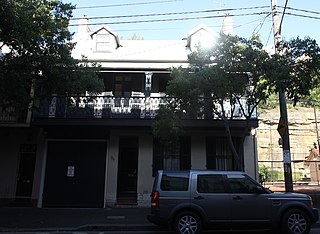
Toxteth is a heritage-listed residence located at 94 Kent Street, in the inner city Sydney suburb of Millers Point, New South Wales, Australia. It was added to the New South Wales State Heritage Register on 2 April 1999.
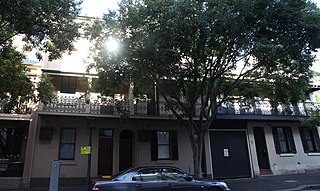
90–92 Kent Street, Millers Point are heritage-listed terrace houses located at 90–92 Kent Street, Millers Point, City of Sydney, New South Wales, Australia. The property is owned by Department of Housing. It was added to the New South Wales State Heritage Register on 2 April 1999.
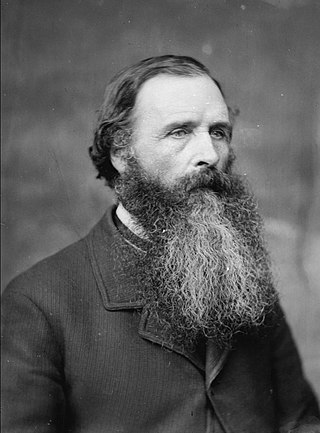
Richard Owens was a Welsh architect, working mostly on urban housing in Liverpool, England and on the construction of chapels in Wales.

The Granby Four Streets is an area in Toxteth, Liverpool, England, comprising four streets at the tip of a triangle near the Grade II* listed Princes Park. The streets, designed by Welsh architect Richard Owens and built by Welsh workers during the late 19th century are Beaconsfield Street, Cairns Street, Jermyn Street and Ducie Street. A fifth street, Granby Street, connects the four streets together and mostly contains commercial units.

Slum clearance in the United Kingdom has been used as an urban renewal strategy to transform low-income settlements with poor reputation into another type of development or housing. Early mass clearances took place in the country's northern cities. Starting from 1930, councils were expected to prepare plans to clear slum dwellings, although progress stalled upon the onset of World War II.
The city of Liverpool in Merseyside, England includes a diverse variety of historical housing architectures, some dating back several hundred years, from small working class terrace houses to larger mansions, mostly from the Victorian era. While many remain in the present day, large numbers were demolished and redeveloped during the slum clearances of the 1960s and 1970s and of those that survived, many have since been refurbished.
